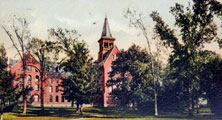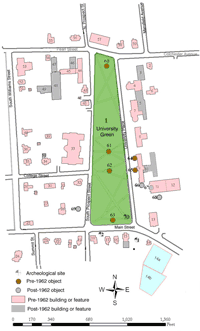 |
University Green Area Heritage StudyHistoric Burlington Research Project - HP 206Historic Preservation Program - University of Vermont |
Lebenslinie/Lifeline SculptureThe lifeline is carved from two blocks Vermont serpentine measuring 44”x28.3”x4” set in a wooden frame.(1) The sculpture is the result of gifts from private donors to the University of Vermont Center for Holocaust Studies. It was installed on the grounds of Wheeler House in August of 2002.(2) Wheeler House was selected as the site for the sculpture because it is the home of the history department which teaches classes on German history.(3) Wheeler House is also rumored to have been a stop on the Underground Railroad and the connection between the experience of American slaves and Jewish people in the Holocaust was important.(4) The Lifeline was created by German artist Klaus Herbrich as part of an artist exchange program between Vermont and German artists working at Dachau.(5) One critic observed that the artist “saw his sculpture as a symbol for lost unity, but with the lifeline of hope running through it.”(6) The artist said, “I see the neat rectangles of the stones as rigid ideological confines that can separate us from each other through racial, political, and religious differences. By aligning the stone, we break the vein; by moving the imaginary borders, we can become each others’ life line. The choice is ours.”(7) In addition to representing the experience of the Holocaust, Herbrich also thought the message would be applicable to the history of slavery in America.(8) Text by Rachel J. Peterson (1)Fax to Kathy Johnson from Mike Gonzalez. Courtesy of the UVM Center for Holocaust Studies.
(2)“Art and Architecture at UVM,” University of Vermont, accessed October 2011, 10, www.uvm.edu/~wlipke/artuvm/toptenseven.php.
(3)“Lebenslinie/Lifeline”. Courtesy of the UVM Center for Holocaust Studie.
(4)Ibid.
(5)“Art and Architecture at UVM,” University of Vermont, accessed October 2011, 10, www.uvm.edu/~wlipke/artuvm/toptenseven.php.
(6)Ibid.
(7)Klaus Herbrich, “Lifeline.” Courtesy of the UVM Center for Holocaust Studies.
(8)“Sculpture Finds a Permanent Home,” accessed November 10, 2011, www.uvm.edu/~uvmchs/documents/f-bull-02.pdf .
|
